
Mahogany is a straight-grained, reddish-brown timber of three tropical hardwood species of the genus Swietenia, indigenous to the Americas and part of the pantropical chinaberry family, Meliaceae. Mahogany is used commercially for a wide variety of goods, due to its coloring and durable nature. It is naturally found within the Americas, but has also been imported to plantations across Asia and Oceania. The mahogany trade may have begun as early as the 16th century and flourished in the 17th and 18th centuries. In certain countries, mahogany is considered an invasive species.

The green wood hoopoe is a large, up to 44 cm (17 in) long tropical bird native to Africa. It is a member of the family Phoeniculidae, the wood hoopoes, and was formerly known as the red-billed wood hoopoe.
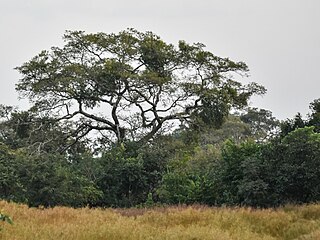
The National Park of Upper Niger is a national park in Guinea that was gazetted in January 1997 with a core area of 554 km2 (214 sq mi). The park protects important tracts of forest and savannah, and is considered a conservation priority for West Africa as a whole.

Entandrophragma cylindricum is a tree of the genus Entandrophragma of the family Meliaceae. It is commonly known as sapele or sapelli or sapele mahogany, as well as aboudikro, assi, and muyovu.

Khaya is a genus of five tree species in the mahogany family Meliaceae. The timber of Khaya is called African mahogany, and is valued as a substitute to American mahogany.
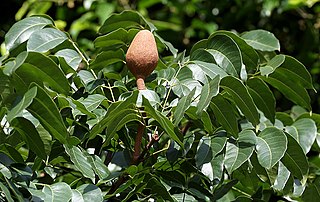
Swietenia is a genus of trees in the chinaberry family, Meliaceae. It occurs natively in the Neotropics, from southern Florida, the Caribbean, Mexico and Central America south to Bolivia. The genus is named for Dutch-Austrian physician Gerard van Swieten (1700–1772). The wood of Swietenia trees is known as mahogany.
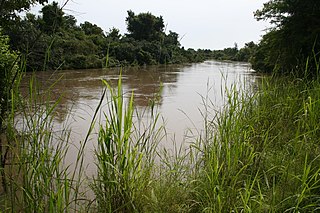
Benin has varied resources of wildlife comprising flora and fauna, which are primarily protected in its two contiguous protected areas of the Pendjari National Park and W National Park. The former is known for many species of avifauna and the latter park is rich in mammals and predators. In addition, many other forest reserves are noted in the country but are not easily accessible, well protected or adequately surveyed for its wildlife resources. The protected area of Benin which is defined as a National Protected Area System is in northern Benin, mostly with a woody savanna ecosystem. It covers 10.3% of the nation and is part of the three-nation W-Arly-Pendjari Complex (WAP).

The wildlife of the Gambia is dictated by several habitat zones over the Gambia's land area of about 10,000 km2. It is bound in the south by the savanna and on the north by the Sudanian woodlands. The habitats host abundant indigenous plants and animals, in addition to migrant species and newly planted species. They vary widely and consist of the marine system, coastal zone, estuary with mangrove vegetation coupled with Banto Faros, river banks with brackish and fresh water zones, swamps covered with forests and many wetlands.
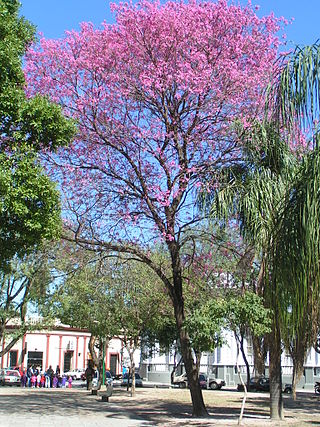
Handroanthus impetiginosus, the pink ipê, pink lapacho or pink trumpet tree, is a tree in the family Bignoniaceae, distributed throughout North, Central and South America, from northern Mexico south to northern Argentina. Along with all the other species in the Handroanthus genus, it is the national tree of Paraguay.

Afzelia africana, the African mahogany, afzelia, lenke, lengue, apa, or doussi, is a Myrmecophyte tree species in the family Fabaceae.

Khaya anthotheca, with the common name East African mahogany, is a large tree species in the Meliaceae family, native to tropical Africa.
Khaya grandifoliola, also called African mahogany, Benin mahogany, large-leaved mahogany, or Senegal mahogany, is a species of plant in the family Meliaceae. It is found in Benin, the Democratic Republic of the Congo, Ivory Coast, Ghana, Guinea, Nigeria, Sudan, Togo, and Uganda. It is threatened by habitat loss.

Khaya ivorensis, also called African mahogany or Lagos mahogany, is a tall forest tree with a buttressed trunk in the family Meliaceae. It is found in Angola, Cameroon, Côte d'Ivoire, Gabon, Ghana, Liberia, and Nigeria where it grows primarily in lowland tropical rainforests. It is threatened by habitat loss.

Pterocarpus santalinoides is a tree species in the legume family (biology) (Fabaceae); it is locally known as mututi.
Testulea is a monotypic genus of plants in the family Ochnaceae. It contains only one species, Testulea gabonensis, an endangered species native to Central Africa.

Annona senegalensis, commonly known as African custard-apple, wild custard apple, wild soursop, abo ibobo, sunkungo, and dorgot is a species of flowering plant in the custard apple family, Annonaceae. The specific epithet, senegalensis, translates to mean "of Senegal", the country where the type specimen was collected.
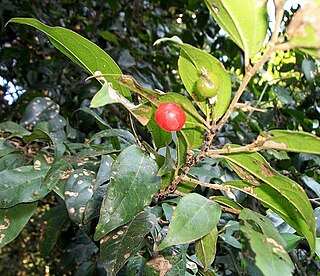
Celtis mildbraedii is a species of forest tree in the family Cannabaceae. It was previously assigned to the family Ulmaceae. These trees grow in limited areas of South Africa, Mozambique and Zimbabwe. They are also found in forested areas from West Africa to Sudan, DRC, Angola and Tanzania. Common names include natal white stinkwood, red-fruited white-stinkwood and natal elm. This species is more common in Tropical Africa than in Southern Africa.
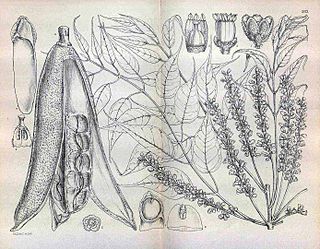
Entandrophragma caudatum, or mountain mahogany, is a large Southern African tree belonging to the mahogany family and found in eastern and north eastern South Africa, Eswatini, Botswana, Angola, the Caprivi Strip region of Namibia, Zimbabwe, Zambia and Malawi. Kew currently recognises 12 other species of Entandrophragma, all with a tropical and sub-tropical African distribution.

Annickia affinis is small to medium sized tree that grows up to 30m tall, it belongs to the Annonaceae family. Also known as the African yellow wood, it is widely used in Central Africa and parts of West Africa in the treatment of various diseases. Both Annickia affinis and Annickia chlorantha are widely studied and sometimes credited with the name Enantia chrlorantha.

Sterculia setigera is a deciduous tree species within the Malvaceae family. It commonly occurs in the Sahelo-Sudan and Guinea savannah zones of Tropical Africa. Among the Hausa people it is known as Kukkuki. It is an important tree crop in Senegal as Gum karaya obtained from the woody species is exported from the country.























